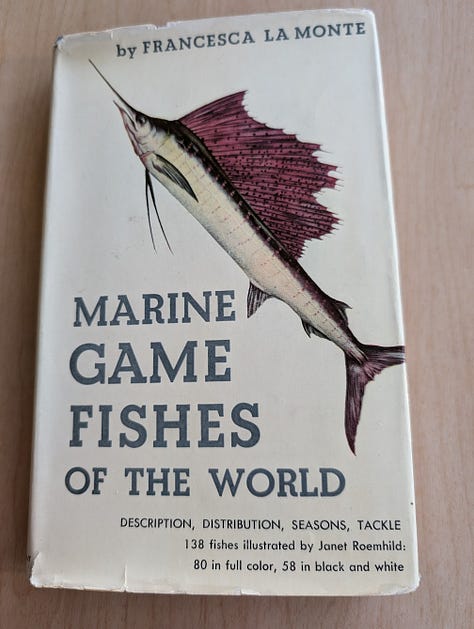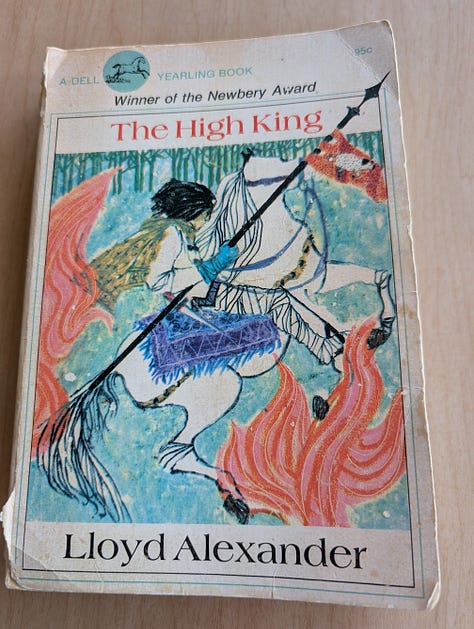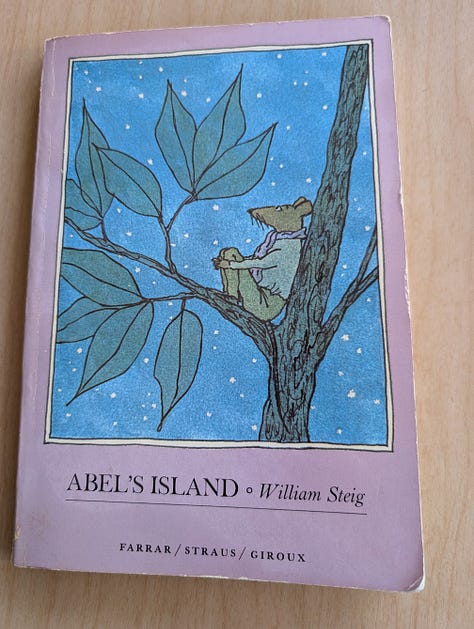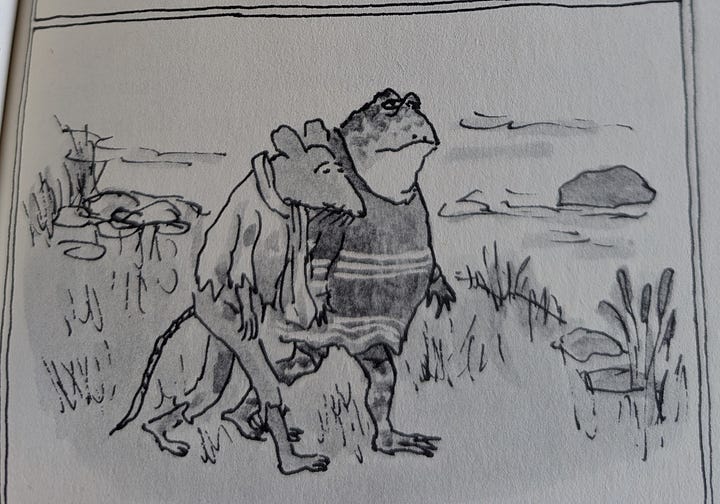Last month at the perfect1 Portland bookstore Revolutions Bookshop, I bought:



Marine Game Fishes of the World [1952] with 80+ color plates
1970’s Dell Yearling editions of The Castle of Lyr and The High King from Lloyd Alexander’s Chronicles of Prydain series - for my husband, who is rereading them
At the last minute, from the bargain table, a 1985 Farrar & Geroux edition of Abel’s Island by William Steig - [inscribed: To Darling Sasha, We Love You! Aunt Sophie Dec 1986]
I was sure I already had a copy of Abel’s Island, so this was a “just in case” purchase - do you make those? Lucky, though, because it turns out I didn’t own it and my husband had never read it, so it is our current read-aloud, a chapter a night when we’re not too tired. It’s a slight book, only 118 pages, many of them Steig’s wavery ink illustrations, but as I re-read it, I wondered: How does this make sense as a children’s classic? How did it get published, and why do kids love it?
How it got published does make sense, as Steig was a working artist all his life. Born in 1907 to Eastern European immigrants in NYC, his daughter Maggie recalled2:
“...he had wanted to be a writer from the time he was young, but made the decision to be a humorous artist when the stock market crashed in 1929. His father, who had been a house painter, told my father, 'Now it's all up to you.' Since all he knew how to do was draw, that's what he did."
He started at The New Yorker in 1930, and as Roger Angell remembered in his obituary for Steig:
“Touching everyone and influencing none, he was beyond imitation. Only Saul Steinberg, perhaps, produced so many absolute surprises in these pages, or in such volume: a hundred and twenty-one covers and sixteen hundred and seventy-six drawings”.
30+ years and 4 wives later, did he arrive at children’s books, publishing CBD!, a visual humor book, in 1968. He followed with instant classics and Newbery award winners Sylvester and the Magic Pebble (1969), Amos and Boris (1971), Doctor De Soto (1982) and Shrek (1990). Abel’s Island falls in the middle, published in 1976 and winning a Newbery Honor.
The story is a classic tale of marooning and survival, with the mouse Abelard Hassam de Chirico Flint in his perfectly tailored suit, being swept in a storm from his wife Amanda and stranded on an island. His only other company is the clay statues he builds of Amanda and friends, a marauding owl, a phlegmatic frog, and his thoughts. While trying many different strategies to get off the island over the course of a year, Abel ponders mortality, dreams, and what makes a good life. He continually perseveres, trying and failing in new ways to get off the island and back to his happy, comfortable life.


I have a hard time believing a current-day editor wouldn’t ask Steig to dial back the language and the heavy themes to be more “kid-friendly”. Open a random page and here are some words you’ll find:
Obstinate patience
Nourishment
Equinoctial rains
Ancient melancholy, inescapable sorrows, speechless longings, the disappointments, the regrets, and cold miseries. (p.48)
Perfect fare for the 8-12 year old, right? It turns out, yes. What kids’ lit masterpieces are we losing to using kid-level language and exactly 32 pages or 50,000 words formulas? When it’s physically and technologically possible to take more risks in publishing, why does imagination and trusting kids’ intellect and deep feelings seem further away in 2025 than 1976?
Over and over, reviewers recognize and appreciate that Steig is not interested in simplifying the human experience for children, and that he innately knows kids want more. From the original NYT review of the book:
“Abel's writer is an able writer and a wonderful illustrator. His characters are intelligent and speak a toney English laced with jolly slang. Abel, being something of a self‐styled intellectual, cannot talk down to his audience, so the young reader will have to read up.”
Read up! Do we ask that of kids - or ourselves - very often these days?
In a profile of Steig at 90, Sarah Boxer asks Steig why his vocabulary is so unyielding:
“In other books, Mr. Steig manages to slip in words like ''cloaca'' and ''cleave,'' little linguistic messes for the parents to clean up. Why does he do that? ''Kids like those words.”
It’s not just the language that expects more of and nudges along kids; his themes have a dark edge and a search for meaning. In a 2019 appreciation of Steig by Ruuman Alam:
“[Amos and Boris] is a tale of unlikely friendship, but it’s also something deeper: a story about what it’s like to be alive. Amos, adrift in the waves, grapples with mortality. “He began to wonder what it would be like to drown. Would it take very long? Would it feel just awful? Would his soul go to heaven? Would there be other mice there?” In that way of overprotective parents, I used to skip this passage, before my kids were old enough to catch me bowdlerizing. By the time we’re toddlers, we are in some way aware of the brute fact of death. Young readers are lucky to have a writer this good to illuminate the subject for them.
Abel’s Island is also for 50-year-old readers, muddling their way through life, trying to keep afloat in a world that seems intent on pulling them from their armchair by the fire with a good book, to become a better mouse.
As 10-year-old Michelle P. wrote (perfectly) in her book review of Abel’s Island:
“If you like hamsters and mice, then I suggest you read this book. Adventures, travels, and artistic drawings are all in Abel’s Island. Abel is just as hard-working as a human. Would you like to read about that? You should also read this book because the author is trying to let you know how it feels to be on an island with such a small body.
If there’s a better description about being human and contemplating our vast universe and the blip of time we occupy, I don’t know it. Kids want to think about love, purpose, survival, longing, and they can pair those big thoughts with big words. We just have to let them.
Perfect because it is sells used and new books and record, describes itself as academia meets punk rock, anti-racist/anti-fascist, on a great little strip of the outlier neighborhood of St. Johns. I always leave with way too many books.
FSG Issues William Steig E-books, (2013, August 22). Publishers Weekly Online.




This is so sweet. I love books more than anything and enjoyed the way you've talked about these ones.
I’ll never forget when my three year old Lucy got to choose any book at a new bookstore in LA and she chose Rotten Island. It became an immediate favorite and I swear it had a lot to do with the neatly teenaged person she is today. We were always obsessed with all William Steig and we have the exact same copy of Abel’s island but have never read it. We’ll get right on that!